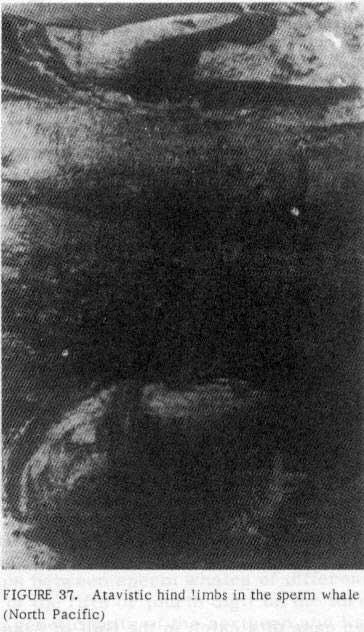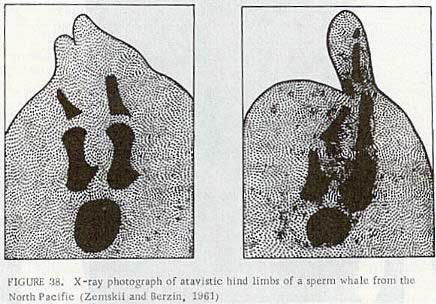HIND LIMB RUDIMENTS FOUND ON MODERN DAY WHALES
EXAMPLE #1
In 1958 we examined a male Sperm Whale 11.6 meters long caught in the Bering Sea, with unusual protrusions in the pelvic region and along the sides of the genital fold (see Figure #1) with a total length of 28 and 34 centimeters, pigmented like the rest of the body. The section of the left protrusion that extended from the body had the appearance of the rounded blade of a propeller, while the right one looked like a fin with finger-shaped processes. The bones were enclosed in dense connective tissue. Judging from an X-ray photograph (see Figure #2) of the skeleton of the protrusions in this specimen, the section of the protrusions that lay inside the body corresponded to the femur, and the middle section to the tibia and the fibula. The section of the protrusions that extended from the body corresponded to the step of the hind limb, and the elements composing it are probably phalanges of the digits. According to the number of phalanges visible in the X-ray photograph, these are the fifth and fourth digits. The skeleton of these limbs is distinguished from the typical structure of the skeleton of the pentadactyl limb of mammals by the absence of tarsal elements. It may be, however, that they were simply not found due to their small size, weak ossification, and the abundance of connective tissue.
SOURCE: Zembskii, V. A., and Berzin, A. A. (1961) "On the Rare Phenomenon of Atavism in the Sperm Whale." Nauchnye Doklady Vysshei Shkoly. Series "Biologicheskie Nauki." Translated and cited in Berzin, A. A. (1972) The Sperm Whale. Pacific Scientific Research Institute of Fisheries and Oceanography. Israel Program for Scientific Translations, Jerusalem. Available from the U. S. Dept. of Commerce, National Technical Information Service. Springfield, VA. p. 65-67

Figure 1

Figure 2
This diagram goes with the previous example


No comments:
Post a Comment